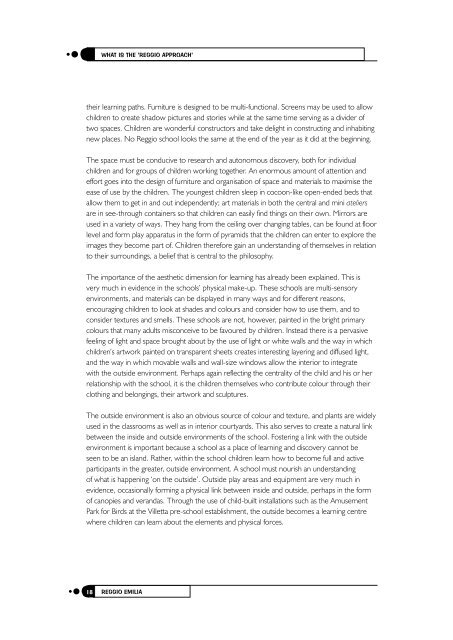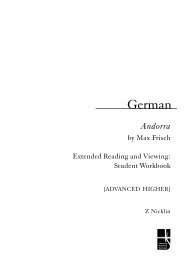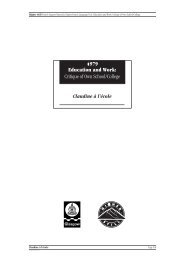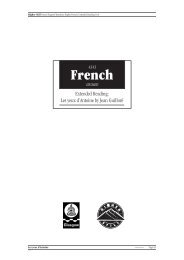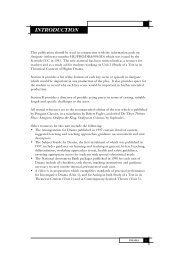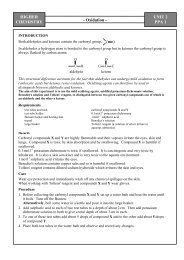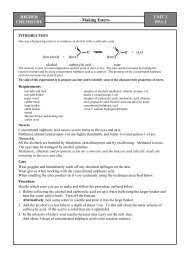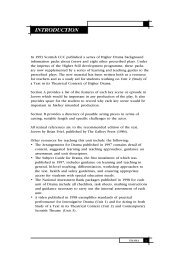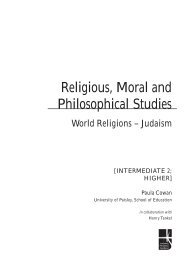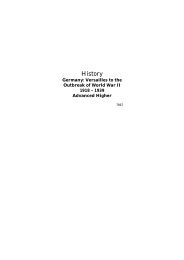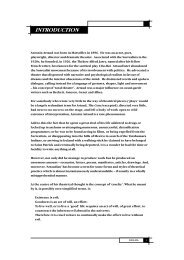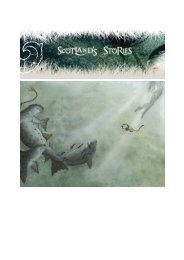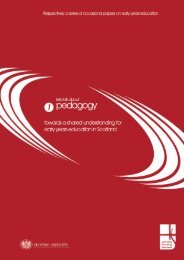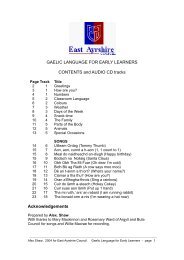The Reggio Emilia Approach to Early Years - Education Scotland
The Reggio Emilia Approach to Early Years - Education Scotland
The Reggio Emilia Approach to Early Years - Education Scotland
You also want an ePaper? Increase the reach of your titles
YUMPU automatically turns print PDFs into web optimized ePapers that Google loves.
WHAT IS THE ‘REGGIO APPROACH’<br />
their learning paths. Furniture is designed <strong>to</strong> be multi-functional. Screens may be used <strong>to</strong> allow<br />
children <strong>to</strong> create shadow pictures and s<strong>to</strong>ries while at the same time serving as a divider of<br />
two spaces. Children are wonderful construc<strong>to</strong>rs and take delight in constructing and inhabiting<br />
new places. No <strong>Reggio</strong> school looks the same at the end of the year as it did at the beginning.<br />
<strong>The</strong> space must be conducive <strong>to</strong> research and au<strong>to</strong>nomous discovery, both for individual<br />
children and for groups of children working <strong>to</strong>gether. An enormous amount of attention and<br />
effort goes in<strong>to</strong> the design of furniture and organisation of space and materials <strong>to</strong> maximise the<br />
ease of use by the children. <strong>The</strong> youngest children sleep in cocoon-like open-ended beds that<br />
allow them <strong>to</strong> get in and out independently; art materials in both the central and mini ateliers<br />
are in see-through containers so that children can easily find things on their own. Mirrors are<br />
used in a variety of ways. <strong>The</strong>y hang from the ceiling over changing tables, can be found at floor<br />
level and form play apparatus in the form of pyramids that the children can enter <strong>to</strong> explore the<br />
images they become part of. Children therefore gain an understanding of themselves in relation<br />
<strong>to</strong> their surroundings, a belief that is central <strong>to</strong> the philosophy.<br />
<strong>The</strong> importance of the aesthetic dimension for learning has already been explained. This is<br />
very much in evidence in the schools’ physical make-up. <strong>The</strong>se schools are multi-sensory<br />
environments, and materials can be displayed in many ways and for different reasons,<br />
encouraging children <strong>to</strong> look at shades and colours and consider how <strong>to</strong> use them, and <strong>to</strong><br />
consider textures and smells. <strong>The</strong>se schools are not, however, painted in the bright primary<br />
colours that many adults misconceive <strong>to</strong> be favoured by children. Instead there is a pervasive<br />
feeling of light and space brought about by the use of light or white walls and the way in which<br />
children’s artwork painted on transparent sheets creates interesting layering and diffused light,<br />
and the way in which movable walls and wall-size windows allow the interior <strong>to</strong> integrate<br />
with the outside environment. Perhaps again reflecting the centrality of the child and his or her<br />
relationship with the school, it is the children themselves who contribute colour through their<br />
clothing and belongings, their artwork and sculptures.<br />
<strong>The</strong> outside environment is also an obvious source of colour and texture, and plants are widely<br />
used in the classrooms as well as in interior courtyards. This also serves <strong>to</strong> create a natural link<br />
between the inside and outside environments of the school. Fostering a link with the outside<br />
environment is important because a school as a place of learning and discovery cannot be<br />
seen <strong>to</strong> be an island. Rather, within the school children learn how <strong>to</strong> become full and active<br />
participants in the greater, outside environment. A school must nourish an understanding<br />
of what is happening ‘on the outside’. Outside play areas and equipment are very much in<br />
evidence, occasionally forming a physical link between inside and outside, perhaps in the form<br />
of canopies and verandas. Through the use of child-built installations such as the Amusement<br />
Park for Birds at the Villetta pre-school establishment, the outside becomes a learning centre<br />
where children can learn about the elements and physical forces.<br />
REGGIO EMILIA


